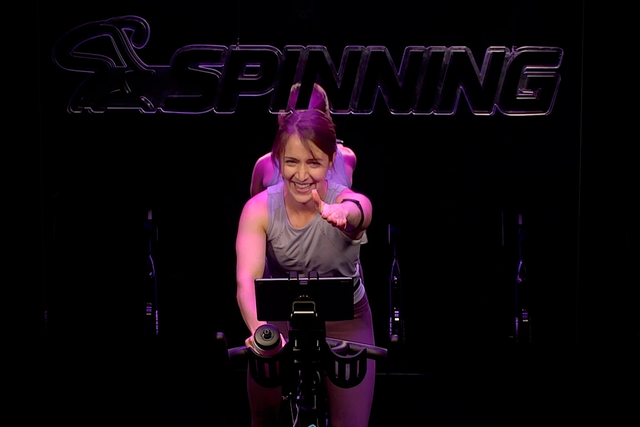This article was contributed by Olivia Ellis, a Spinning® Master Instructor who has a Masters in Exercise Science as well as a Masters in Positive Developmental Psychology.
Have you ever paid attention to the thoughts that run through your mind during a Spinning® class? Often, we find ourselves in an energized, joyful state while riding, and our thoughts are uplifting, motivating and empowering! But let’s be honest—sometimes we’re not feeling so successful and our thoughts can pull us down. We can sometimes say things to ourselves that are downright self-defeating. "I wasn’t able to hold the same cadence for the entire interval. I must be a failure." That line of thinking doesn’t feel great and isn’t supportive of our riding. The reality is, sometimes we all have thoughts that aren’t very nurturing, but there are strategies we can use to minimize these self-defeating thoughts and replace them with positive messages. Being aware of our thoughts, understanding how we can change them, and giving ourselves the time to make those changes, can influence our time on the bike and whether we stick to our health goals. So how can we use the power of our amazing brains to our advantage?
1. Become Aware of Your Thoughts
Without judging, listen to the conversation you’re having with yourself. Sometimes the conversation is positive, nurturing, and rational. However, self-defeating thoughts can sometimes sneak into our workouts which can limit performance and even adherence to our physical activity program. When our thinking is more positive and rational, we have the ability to positively influence our behaviors (Beck, 2020). For example, when you fill your head with positive, healthy, rational thoughts about cycling, then you may be more likely to act in line with your health goals.
2. Changing Your Thought Patterns
The human brain is really amazing. It has a network of tunnels called neuropathways. The more we think a certain thought, the greater that neuropathway expands, and the more often we will think that thought in the future. If we notice we are thinking certain thoughts often, and make an effort to change our thinking patterns, we can narrow the neuropathway which makes it less likely we will think that way in the future (Gynther et al., 1998).
These adaptations are called neuroplasticity, which means we can change the structure of our brain through our thinking. For example, if I’m on my Spinner® bike and I’m looking at the person next to me thinking “I’ll never be as strong as they are,” this self-defeating thought may not be very motivating. However, if I catch myself, I can observe the thought and then replace it with a more rational one: “It’s not that I can never be that strong, it’s just that the other rider has been taking this class for a longer period of time. And I have actually noticed myself getting stronger since I started riding!” Understanding that we can change self-defeating or negative thoughts on the bike, and replace them with more positive, rational thoughts can help influence our behaviors moving forward and impact whether we can stick to our health and cycling goals.
3. Recognize It’s a Process
Changing our thinking patterns doesn’t happen overnight. Minimizing self-defeating thoughts takes time and effort. But over time, the small changes we make can create a large ripple effect in our day to day lives. Changing our thoughts to more rational, positive thoughts can help us stay motivated and even help with performance on the bike. If you notice those self-defeating thoughts, again, you’re not alone. We all have them. But we also have the power to change them.
| Try putting these strategies into play by joining me for my Spinning® Digital ride called “Stand in Your Strength”! We can work together to become physically and mentally stronger on the bike. I look forward to seeing you there! |
References:
- Beck, Judith S. Cognitive Behavior Therapy Basics and Beyond. 3rd ed., The Guilford Press, 2020.
- Gynther, B. D., Calford, M. B., & Sah, P. (1998). Neuroplasticity and Psychiatry. Australian & New Zealand Journal of Psychiatry, 32(1), 119–128. https://doi.org/10.3109/00048679809062718






Leave a comment
This site is protected by hCaptcha and the hCaptcha Privacy Policy and Terms of Service apply.